Yorba Linda, CA-based Flavours, Inc. is a co-packer of functional foods and nutritional products. Born from the owners’ expertise in flavor formulation and high-volume aseptic processing, the company has carved out a unique niche that caters to new product development.
From test runs as small as 15 gal to production runs up to 8,000 gal, Flavours has the ability to take a project from concept to commercialization in the low-acid extended shelf life (ESL), high-acid, and preserved nutritional product categories. Among its market successes are the development of multinational brands such as FRS, Bolthouse Farms, and Naked Juice.
“We consider ourselves very lucky to be able to launch new products and concepts cost-effectively for our customers,” says Flavours COO Brian Patterson. “What was built into this facility was high speed, quick changeover, increased WIP [Work in Process] velocity, flexible packaging systems on the back end, and smaller lot sizes.”
The company’s 60,000-sq-ft Yorba Linda plant was commissioned in 2009 and is one of the few co-packing facilities to offer three methods of aseptic processing: tubular, steam injection, and plate and frame. Its flexibility extends to package type, as well. The operation can accommodate glass, PET, and high-density polyethylene bottles, in sizes from 2 oz to 64 oz. On the day of Packaging World’s visit, Flavours was running a 33.8-oz PET bottle of strawberry daiquiri mix on its bottling line.
“We are the only company in the U.S. that can incubate a product concept such as functional nutritional products in different delivery forms,” says CEO Joshua Cua. “We want to be as customer-driven as possible and provide the best delivery form to meet our customers’ requirements.”
A full-service model for aseptic packaging
When Cua, along with Priscilla Latter and Julie Hodson, formed Flavours in 2003, the industry was migrating toward smaller runs and test runs, explains Patterson. “There wasn’t just a need out there for a co-packer,” he says. “The owners were influential in discovering the need for a cost-effective way to launch new product concepts.”
At the front end, Flavours can work with a brand owner to develop a product from the idea stage, including packaging design, flavor formulation, and product stability testing.
Key to the business was the founders’ 25 years of experience in the development of products, combined with their expertise in aseptic technology. “Aseptic packaging and processing is a challenging business,” notes Patterson. “There are significant barriers to entry, including the technology itself. There are not a lot of people who understand the technology, either from an operational standpoint or from a quality standpoint.”
Another barrier to entry are the many regulatory approvals necessary to start up an aseptic facility, he says. For Flavours, this included approvals from NSF Intl., the FDA, and the State of California. The company also achieved organic status and can provide kosher certification of products.
Finally, the entry cost is also a barrier for newcomers to the field. “For us, this included the cost of custom, specialized equipment that can run small pilot runs, as well as produce products at commercial levels efficiently,” says Patterson.
“What we afford as an aseptic bottler is a product that is filled in a sterile environment that adds shelf life with no refrigeration,” he adds. “Our techniques of homogenization and pasteurization allow for the product to be shelf-stable for up to nine months, give or take, depending on the market.”
Another advantage of the aseptic process is the package design flexibility it presents versus hot-fill products, which require a thicker, heavier-gauge container. “Because our bottles are thinner, lighter weight, and more flexible with curvatures, it allows our customers more marketing breadth and more opportunity to excite the consumer with advantageous labeling and capping,” says Patterson.
Maximum flexibility built-in
As mentioned, Flavours’ liquid aseptic processing technologies include:
• Tubular, which consists of a tube within a tube with a hot-water surround. The indirect process sterilizes product at 220°F plus for 30 sec.
• Steam injection, where product is heated at temperatures from 280°F to 300°F for about four seconds by the direct injection of sterile water. Flash cooling removes the water through evaporation.
• Plate and frame, where indirect steam and/or hot water are used to heat product to 220°F plus for about 30 sec.
The method used to sterilize a product depends upon its technical requirements, as determined by Flavours’ in-house lab. But in general, low-acid ESL products can be processed using steam injection or tubular heat exchangers, while the preferred method for treating high-acid products is tubular or plate-and-frame technology.
Flavours’ equipment includes two processors: a Tetra Therm Aseptic Drink tubular heat exchanger with a 5,000-gal/hr processing speed, and a Tetra Therm Aseptic VTIS for low-acid products that operates at 2,100 gal/hr. Both of the units, supplied by Tetra Pak, can run with or without homogenization.
After processing, products are moved to one of the facility’s two sterile tanks; one holds 5,000 gal, and one holds 8,000 gal. Filling is done in a closed environment on one of three fillers, two of which are rotary and one in-line from Pacific Packaging Machinery. Flavours also offers aseptic bag-in-box packaging, using a Scholle SureFill® high-acid aseptic filling system from Scholle Packaging.
From there, the balance of Flavours’ packaging equipment was chosen for “its flexibility, its ease of use, whether it required less maintenance, and its overall enhancement to the facility,” says Patterson. “Our design criteria was to build increased WIP velocity and increased flexibility in our back-end packaging systems.”
Flavours’ ability to handle multiple packaging sizes quickly is aided by the fact that no changeparts are needed on its equipment for most standard package designs. For custom package applications, the company has an on-site fabrication shop that can create changeparts. “We feel that product development does not stop in our R&D lab,” says Patterson.
Flavours’ packaging equipment includes two Pace Packaging plastic bottle unscramblers; a Cognex fill-level inspector; and two sleeve-label applicators, one from Linker Equipment Corp. and one from Eversleeve Enterprise Co. (Esleeve). A Quadrel labeler handles pressure-sensitive label applications.
Secondary packaging is accomplished through the use of a case former from SWF Cos.; a Combi Packaging Systems drop packer; and an ARPAC tray former/shrink wrapper.
From small-batch test runs to production-level bulk packaging, Flavours has crafted a unique, comprehensive approach to launching new product concepts into the marketplace.
“We are here to protect our customers’ margins,” says Patterson. “I would like to say that it’s mainly our capabilities that excites them, but I think they also like the cost savings and our range of offerings. They trust us to handle everything for them.”

























